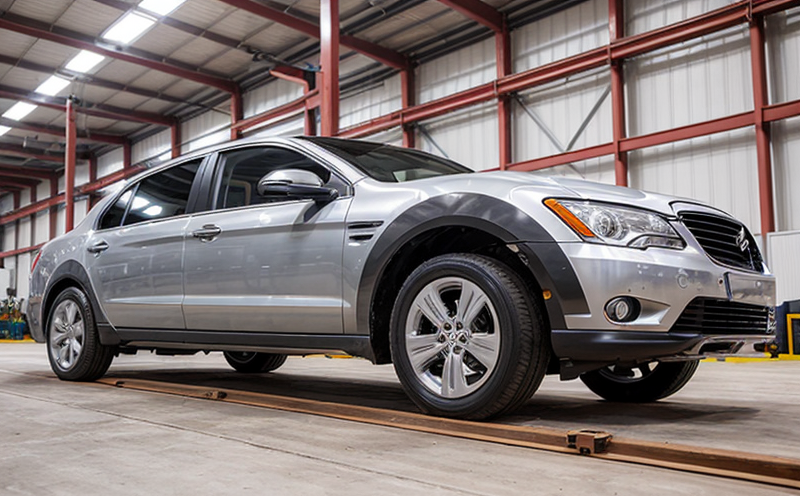ISO 7438 Bend Testing for Manufacturing Integrity
The ISO 7438 standard is pivotal in ensuring that materials and components used in industrial manufacturing are capable of withstanding the mechanical stresses they will encounter during production processes. This test evaluates how a material or component bends under specific conditions, thereby providing insights into its structural integrity and potential for failure.
The process involves subjecting specimens to defined bend angles using controlled testing machines that apply forces in a precise manner. The goal is to determine if the specimen will exhibit any signs of cracking, deformation, or other indicators of material weakness under stress. This test is particularly useful when assessing materials used in high-stress environments such as aerospace, automotive, and construction industries.
Compliance with ISO 7438 is crucial for manufacturers who need to ensure that their products meet international quality standards. By adhering to this standard, companies can enhance the reliability of their products, reduce the risk of product failure, and protect against potential liability issues. The test results are often used in conjunction with other mechanical tests like tensile strength, hardness testing, and fatigue testing.
For R&D engineers, ISO 7438 bend testing offers valuable data that can be used to refine material selection and design processes. Quality managers benefit from this standard by ensuring consistent quality across production batches. Compliance officers can use the results of these tests as part of their audit trails for regulatory compliance.
The test setup includes a bending machine capable of applying controlled forces, along with sensors that measure the applied load and displacement during the bend. The specimen is typically clamped into position before being subjected to the specified bend angle. The testing procedure is meticulously documented, including details on the materials used, the equipment employed, and the parameters set.
The results of ISO 7438 tests are presented in detailed reports that include the test setup, specimen characteristics, applied loads, displacement measurements, and any observed defects or failures. These reports serve as critical documentation for quality assurance and can be used to identify areas for improvement in manufacturing processes.
By leveraging ISO 7438 bend testing, manufacturers can gain a competitive edge by ensuring that their products meet the highest standards of reliability and durability. This not only enhances product performance but also builds customer confidence and trust.
| Industry | Component Type | Test Application |
|---|---|---|
| Aerospace | Engine mounts, turbine blades | Evaluating resistance to high-stress environments |
| Automotive | Structural components, engine blocks | Assessing strength and durability under dynamic loads |
| Bicycle Manufacturing | Rims, handlebars | Ensuring lightweight materials do not compromise safety |
| Construction | Reinforcing bars, structural steel | Evaluating performance under bending forces in concrete structures |
Industry Applications
The ISO 7438 bend test finds extensive application across various industries, ensuring that materials and components are robust enough to withstand the rigors of industrial manufacturing processes. In aerospace, for instance, engine mounts and turbine blades undergo this testing to ensure they can operate reliably under extreme conditions without failure.
In automotive applications, structural components like engine blocks are subjected to ISO 7438 tests to assess their strength and durability when exposed to dynamic loads during vehicle operation. This helps in designing safer and more efficient vehicles.
Bicycle manufacturers use this test on rims and handlebars to ensure that these critical components remain lightweight yet robust, thus enhancing the overall performance of bicycles without compromising safety.
In construction, reinforcing bars and structural steel are tested under bending forces to evaluate their performance in concrete structures. This ensures that buildings and infrastructure can withstand significant mechanical stresses during construction and use.
International Acceptance and Recognition
The ISO 7438 bend test is widely accepted across the globe, particularly in countries with stringent quality control standards. Its international recognition stems from its consistent approach to evaluating mechanical integrity, making it a preferred standard for manufacturers seeking to ensure product reliability.
Many industry leaders in sectors such as aerospace and automotive rely on ISO 7438 compliance to meet regulatory requirements and maintain high-quality standards. The test's global acceptance also facilitates international trade by ensuring that products meet the same rigorous quality benchmarks across different regions.
The standard is closely aligned with other international mechanical testing standards like ISO 10526, which further enhances its credibility and applicability in various contexts. By adhering to these international guidelines, manufacturers can ensure that their products are not only robust but also meet the expectations of global markets.
Use Cases and Application Examples
The ISO 7438 bend test is a critical tool for ensuring the mechanical integrity of materials used in various applications. In aerospace, engine mounts are subjected to this test to evaluate their resistance to high-stress environments. Turbine blades undergo similar testing to ensure they can operate reliably under extreme conditions without failure.
In automotive manufacturing, ISO 7438 tests are conducted on structural components such as engine blocks. These tests assess the strength and durability of these components when exposed to dynamic loads during vehicle operation. This helps in designing safer and more efficient vehicles that meet high performance standards.
Bicycle manufacturers use this test on rims and handlebars to ensure that these critical components remain lightweight yet robust, enhancing the overall performance of bicycles without compromising safety. In construction, reinforcing bars and structural steel are tested under bending forces to evaluate their performance in concrete structures. This ensures that buildings and infrastructure can withstand significant mechanical stresses during construction and use.





